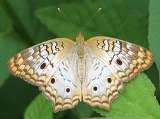
Anartia
Encyclopedia
Anartia is a genus of butterflies
in family
Nymphalidae
, and subfamily Nymphalinae
, found in tropical and subtropical areas in the Americas
. The butterflies are all known as Peacocks, although the common European Peacock
is not in the same genus.
Butterfly
A butterfly is a mainly day-flying insect of the order Lepidoptera, which includes the butterflies and moths. Like other holometabolous insects, the butterfly's life cycle consists of four parts: egg, larva, pupa and adult. Most species are diurnal. Butterflies have large, often brightly coloured...
in family
Family (biology)
In biological classification, family is* a taxonomic rank. Other well-known ranks are life, domain, kingdom, phylum, class, order, genus, and species, with family fitting between order and genus. As for the other well-known ranks, there is the option of an immediately lower rank, indicated by the...
Nymphalidae
Nymphalidae
The Nymphalidae is a family of about 5,000 species of butterflies which are distributed throughout most of the world. These are usually medium sized to large butterflies. Most species have a reduced pair of forelegs and many hold their colourful wings flat when resting. They are also called...
, and subfamily Nymphalinae
Nymphalinae
Nymphalinae is a subfamily of brush-footed butterflies . Sometimes, the Limenitidinae are included here as further tribe, while the Melitaeini are occasionally considered a distinct subfamily.- Systematics:...
, found in tropical and subtropical areas in the Americas
Americas
The Americas, or America , are lands in the Western hemisphere, also known as the New World. In English, the plural form the Americas is often used to refer to the landmasses of North America and South America with their associated islands and regions, while the singular form America is primarily...
. The butterflies are all known as Peacocks, although the common European Peacock
Inachis io
The European Peacock , more commonly known simply as the Peacock butterfly, is a colourful butterfly, found in Europe, temperate Asia as far east as Japan. It is the only member of the genus Inachis...
is not in the same genus.
List of species
- Anartia amatheaAnartia amatheaThe Brown Peacock or Scarlet Peacock is a species of nymphalid butterfly, found primarily in South America. The type locality is probably Surinam, and the species is found from Panama to Argentina; Grenada, Barbados, Antigua...
(Linnaeus, 1758) – Brown Peacock or Scarlet Peacock - Anartia chrysopeleaAnartia chrysopeleaThe Cuban Peacock or Caribbean Peacock is a species of butterfly generally only found in Cuba, although stray specimens have been encountered in Monroe County, Florida.-External links:** at funet.fi...
(Hübner, 1831) – Cuban Peacock or Caribbean Peacock - Anartia fatimaAnartia fatimaThe Banded Peacock or Fatima is a species of butterfly found in the southern United States, Mexico and Central America. More information can be found at: and -External links:** at funet.fi...
(FabriciusJohan Christian FabriciusJohan Christian Fabricius was a Danish zoologist, specialising in "Insecta", which at that time included all arthropods: insects, arachnids, crustaceans and others...
, 1793) – Banded Peacock or Fatima - Anartia jatrophaeAnartia jatrophaeThe White Peacock is a species of butterfly found in the southeastern United States, Central America, and throughout much of South America....
(Linnaeus, 1763) – White Peacock or Masote - Anartia lytreaAnartia lytreaGodart's Peacock Anartia lytrea, is a species of nymphalid butterfly found in Cuba, the Isle of Youth, and the Swan Islands. The butterfly has been known to occasionally stray into the Lower Keys of Florida.-External links:** at funet.fi...
(GodartJean Baptiste GodartJean-Baptiste Godart was a French entomologist.Born at Origny, Godart became impassioned by butterflies in his youth. He was charged by Pierre André Latreille with writing the article on these insects in the Encyclopédie Méthodique...
, 1819) – Godart's Peacock or Hispaniolan Peacock
External links
- A molecular phylogeny of the neotropical butterfly genus Anartia (Lepidoptera: Nymphalidae), Michael J. Blum, Eldredge Bermingham, and Kanchon Dasmahapatra
- Anartia at funet.fi

